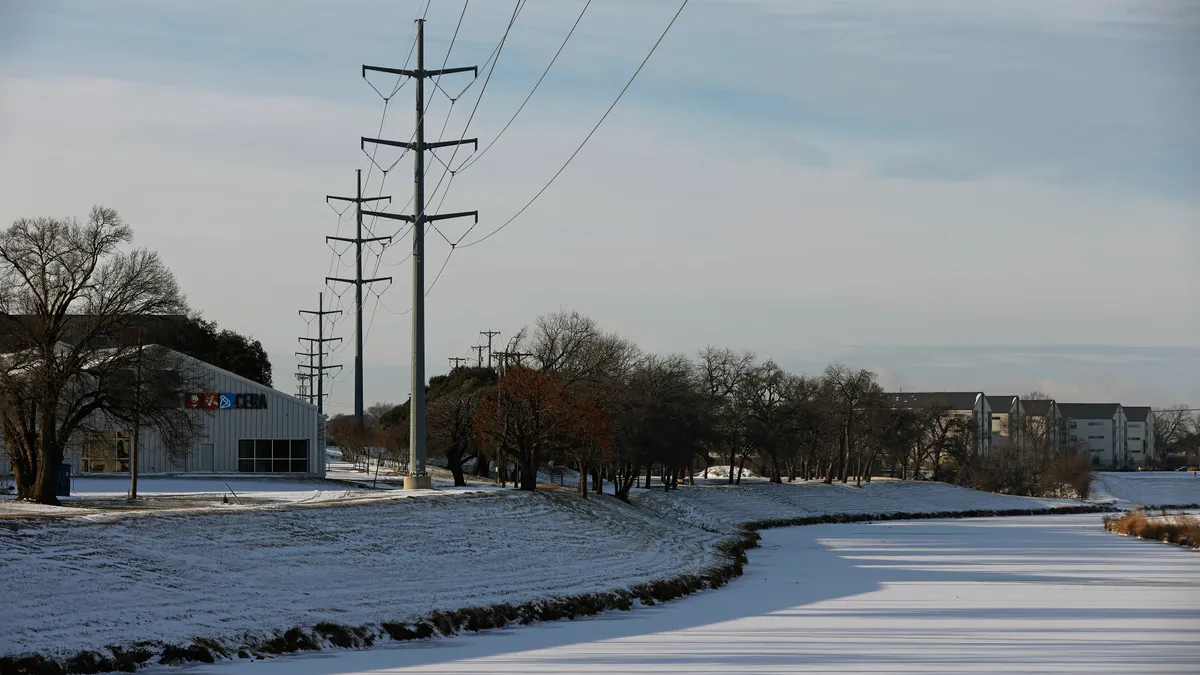Dive Brief:
- Duke Energy officials appeared before the North Carolina Utilities Commission on Tuesday and apologized for rotating power outages instituted Dec. 24 that left about 500,000 customers without service as temperatures plunged and energy demand spiked.
- Duke’s outages in North Carolina and South Carolina made up about a third of the 1.7 million service disruptions during the peak of Winter Storm Elliott. Downed power lines caused outages for some utilities and energy demand exceeded expectations in numerous regions. Utilities supplied by Tennessee Valley Authority service territory faced rotating blackouts for the first time in almost 100 years.
- The Federal Energy Regulatory Commission and North American Electric Reliability Corp. have launched a joint investigation into bulk-power system operations during Elliott, and noted that the storm “underscores the need for the electric sector to change its planning scenarios and preparations for extreme events.”
Dive Insight:
Winter Storm Elliott pushed grid operations to the brink in many regions of the U.S., and caused shortages in others.
“We are sorry for what our customers experienced,” Julie Janson, executive vice president and CEO of Duke Energy Carolinas, told North Carolina regulators. “We regret not being able to provide customers as much advance notice as we would have liked, and acknowledge that the outages themselves lasted far longer than we first expected.”
Duke’s rotating outages were the first ever by the company in the Carolinas, officials said, and were called to prevent potentially larger and longer blackouts. About 15% of Duke’s customers were impacted.
The utility said electricity demand outpaced its expectations while generation capacity fell, and power purchases the company had been relying on were unavailable. The failure of an automated tool used to disconnect and then restore power required some circuits to be restored manually, causing outages to last longer than planned.
“The fast-moving pace of events leading up to the temporary outages did not permit us to be as proactive in our communications as we would have liked,” said Kendal Bowman, Duke’s president of North Carolina operations.
In Tennessee, TVA said it was investigating the need for rotating outages. The government-owned utility provides electricity for more than 150 local power companies serving 10 million people in Tennessee and parts of surrounding states.
“We are conducting a thorough review of what occurred and why,” the utility said. “We are committed to sharing these lessons learned and – more importantly – the corrective actions we take in the weeks ahead to ensure we are prepared to manage significant events in the future.”
Federal regulators said Dec. 28 they also want answers.
“The joint inquiry with NERC we are announcing today will allow us to dig deeper into exactly what happened so we can further protect the reliability of the grid,” then-FERC Chairman Rich Glick said in a statement. Glick has since stepped down and been replaced by Acting Chairman Willie Phillips.
“There will be multiple lessons learned from last week’s polar vortex that will inform future winter preparations,” NERC CEO and President Jim Robb said. He noted that along with load shedding in Tennessee and the Carolinas, “multiple energy emergencies were declared and new demand records were set across the continent.”
To ensure power reliability, the U.S. Department of Energy allowed the Electric Reliability Council of Texas and PJM Interconnection to waive some emissions standards and run generators at their maximum capabilities.
ERCOT peak demand exceeded forecasts by 13 GW, according to energy analyst and Stoic Energy President Doug Lewin.
Underestimating demand is “an egregious mistake, and it scrambles the odds of blackouts through this severe cold snap,” Lewin wrote Dec. 23, the day ERCOT requested the waiver.
While Texas avoided a disaster like Winter Storm Uri in 2021 that caused widespread outages and deaths, Elliott “demonstrates again that Texans will not be able to avoid outages in such severe winter weather events without addressing demand-side solutions,” Lewin said.
PJM officials said their models “under-forecast the peak load by about 10%, but we had what we believed to be a surplus of generation available day-ahead for contingencies.”
The PJM bulk power system remained reliable throughout Winter Storm Elliott and rolling outages were not required, spokesperson Jeffrey Shields said in an email.
“The weather conditions, while extreme, were within the outer limits of the range we had planned for prior to the start of the winter,” he said.
Competitive generators said energy markets and the grid remained relatively stable through the mid-Atlantic, New York and New England.
“The data is still coming in, but if you take just the raw information that's available, New York, New England and PJM managed to successfully get through the severe weather without having rotating outages or blackouts, which I think is very positive,” said Todd Snitchler, president and CEO of the Electric Power Supply Association.
Transfer capacity between grid operators helped keep the lights on in some instances, said Snitchler. At one point, about 3,000 MW of power were “flowing out of PJM through MISO and then into the other regions in the southeast.”
“If there weren't those megawatts available to be wheeled to other parts of the country, what would that have meant in the way of successful grid operation,” Snitchler said. “I would hesitate to speculate, but I can't imagine it would be a positive outcome.”















